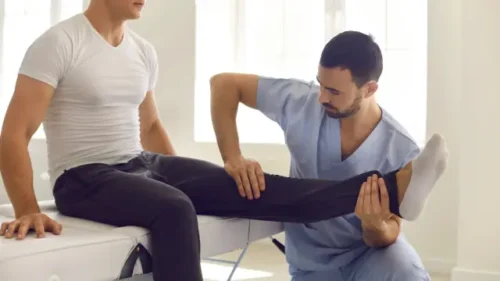
Revive and Thrive: Navigating the Path to Sports Injury Recovery
Sports injuries are an unfortunate but common occurrence in the world of athletics. Whether you’re an amateur athlete participating in weekend competitions or a seasoned professional competing on the grandest stages, the risk of injury is an inherent part of pushing the boundaries of physical performance. However, while sports injury and recovery may momentarily halt your athletic pursuits, they should not define your journey. With the right guidance, support, and a strategic approach, you can navigate the path to recovery and emerge stronger than ever before.
The road to sports injury recovery can be both physically and emotionally demanding. It often requires patience, perseverance, and a multidimensional approach that addresses not only the physical rehabilitation of the injured body part but also the mental and emotional well-being of the athlete. It is a journey that calls for resilience, determination, and a positive mindset. This article explores effective strategies for sports injury recovery, including prevention, treatment, rehabilitation, and the importance of mindset.
Prevention: The Key to Longevity
Prevention is always better than cure, and when it comes to sports injuries, this adage holds true. Athletes must adopt a proactive approach by prioritizing prehabilitation, a concept that goes beyond simply warming up before a workout. Prehabilitation involves conditioning the body and addressing any muscular imbalances or weaknesses that may predispose athletes to injuries.
By incorporating strength and conditioning exercises into their training routine, athletes can enhance their overall physical resilience. This includes exercises that target specific muscle groups, improve stability, and enhance flexibility. Working with a qualified strength and conditioning coach or physical therapist can provide valuable guidance in designing a prehabilitation program tailored to an athlete’s specific needs and goals.
In addition to prehabilitation, utilizing proper protective gear is paramount in reducing the risk of injuries. Whether it’s helmets, mouthguards, shin guards, or knee pads, protective equipment acts as a crucial line of defense, absorbing impact and minimizing the potential for severe injury. Athletes should ensure that their gear fits properly and is well-maintained, replacing any damaged or worn-out equipment promptly.
Warming up adequately before engaging in physical activity cannot be overstated. A dynamic warm-up routine that includes a combination of stretching, mobility exercises, and light cardiovascular activity helps prepare the body for the demands of intense training or competition. This promotes blood flow to the muscles, increases body temperature, and improves joint mobility, reducing the risk of strains, sprains, and other soft tissue injuries.
Maintaining good form during training and competition is another crucial aspect of injury prevention. Proper technique and body mechanics minimize the strain on muscles, tendons, and joints, reducing the likelihood of overuse injuries or acute trauma. Athletes should work closely with coaches or trainers to ensure they receive proper instruction on technique and receive feedback to correct any deviations that may put them at risk.
Regular check-ups with a sports medicine professional should not be overlooked. These professionals have specialized knowledge and expertise in assessing an athlete’s physical condition and identifying any potential areas of concern. Through regular examinations, screenings, and diagnostic tests, they can detect underlying issues, provide guidance on injury prevention strategies, and develop personalized plans to optimize performance and reduce the risk of injuries.
In summary, prevention is a cornerstone of sports injury management. Athletes must prioritize prehabilitation, utilize proper protective gear, warm up adequately, maintain good form, and seek regular check-ups to mitigate the risk of injuries. By incorporating these preventive measures into their athletic routine, athletes can minimize setbacks, stay in the game, and pursue their sports with greater confidence and longevity.
Treatment Options: Beyond Surgery
When an injury does occur, it’s important to explore various treatment options before considering surgery. While surgery may be necessary for severe cases, non-surgical alternatives can often provide effective relief. Physical therapy, chiropractic care, and regenerative medicine techniques are gaining popularity in the realm of sports injury treatment. Regenexx in Asheville, for example, offers non-surgical procedures that utilize the body’s natural healing capabilities to repair damaged tissues, ligaments, and tendons. These innovative approaches can accelerate the healing process and reduce the need for invasive surgical interventions.
Rehabilitation: Restoring Strength and Function
Rehabilitation plays a vital role in sports injury recovery, serving as a bridge between injury and returning to peak performance. It encompasses a comprehensive program tailored to the specific needs of the injured athlete, focusing on restoring strength, flexibility. And functionality to the affected area. With the guidance of a skilled physical therapist or sports rehabilitation specialist. Also athletes engage in targeted exercises, stretching routines, and progressive training protocols. This carefully crafted regimen aims to rebuild damaged tissues, improve range of motion, and enhance muscular strength and endurance.
Patience and dedication are crucial during this phase, as athletes must gradually increase the intensity of their exercises to prevent re-injury and promote a sustainable and lasting recovery. The rehabilitation process not only rehabilitates the injured body part but also helps athletes regain confidence in their physical abilities. This fostering a positive mindset and setting the stage for a triumphant return to sports.
Mental Resilience: Overcoming Challenges
The journey of sports injury recovery can be mentally and emotionally taxing, requiring athletes to overcome not only physical obstacles but also psychological challenges. Setbacks, frustration, and self-doubt often accompany the healing process. That’s why nurturing mental resilience is just as crucial as physical rehabilitation. Cultivating a positive mindset becomes essential in staying motivated and maintaining optimism throughout the recovery journey. Seeking support from loved ones, friends, and teammates can provide a valuable network of encouragement.
Working with a sports psychologist can offer additional guidance in managing the emotional aspects of recovery. Then helping athletes develop coping strategies and techniques to overcome adversity. Visualizing success, setting realistic goals, and maintaining a strong sense of purpose can fuel motivation. Also ignite determination, and expedite the return to sports. By addressing both the physical and psychological components of sports injury recovery, athletes can build the resilience necessary to thrive and emerge stronger from the experience.
Returning Stronger: A New Beginning
The final phase of sports injury recovery is the triumphant return to the field or court. After months of hard work, dedication, and perseverance, athletes can reclaim their place in the game they love. It’s important to approach this stage with caution, gradually reintroducing physical activity and monitoring for any signs of lingering issues. Regular check-ups and continued preventive measures can help prevent future injuries and ensure long-term athletic success.
Reviving and thriving after a sports injury is a challenging but rewarding journey. By prioritizing injury prevention, exploring non-surgical treatment options, engaging in targeted rehabilitation, nurturing mental resilience. And approaching the return to sports with care, athletes can overcome adversity and regain their competitive edge. Remember, recovering from a sports injury is not just about healing the body. It’s about strengthening the mind, embracing the process, and coming out stronger on the other side.


